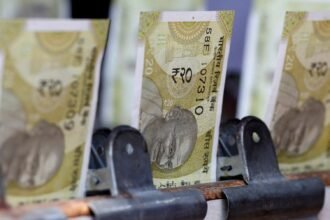Economist Alicia Herrero says that 5 August’s “Black Monday” global stock market rout may not be a one-off event. Much of the story will unfold in Asia. In particular, what happens in Japan’s financial markets may have global impacts and will surely have regional ripple effects.
August is a tricky month for markets as liquidity is scarce and volatility is minimal until something happens. The few traders who remain at their desks while everybody else is on holiday know well that calm can burst easily with a piece of bad economic news or a geopolitical event.
5 August’s “Black Monday” is not the first of such events. In August 2015 when China’s stock market collapsed and the RMB was devalued, global stock markets tanked. In August 2011, US and global stocks also declined sharply amid concerns over the US debt ceiling crisis, followed by the eurozone debt crisis. August 2007 marked the start of the subprime mortgage crisis, with an important correction of the stock market due to liquidity issues in the credit markets. In August 1998, the Russian financial crisis and the collapse of the hedge fund Long-Term Capital Management triggered a global stock market sell-off.
… tech stocks have been doing poorly for weeks, due to weaker than expected results, and mostly plummeted on Monday… The fact that the hype on artificial intelligence seems to be receding does not help either.
Some of the above events were more long-lasting than others but it was hard to distinguish among them when they started. The least permanent was that of August 2011, at least for the US, with the S&P 500 regaining most of its losses by the end of August but it got more complicated in Europe as the European sovereign debt crisis spread further. The longest and deepest correction of stock markets among the above was obviously August 2007 since the subprime crisis led to concerns about the overall health of the US financial system and finally the collapse of Lehman Brothers in September 2008 with global reverberations.
The question is where are we now and what to expect. When analysing the reasons for the recent Black Monday, one can identify three relevant ones. Firstly, the poor US labour data published the Friday before, which led to fears of a hard landing or even a recession. Secondly, tech stocks have been doing poorly for weeks, due to weaker than expected results, and mostly plummeted on Monday especially for “The Magnificent Seven” (Alphabet, Amazon, Apple, Meta, Microsoft, Nvidia, and Tesla), starting with Nvidia which suffered the biggest drop. The fact that the hype on artificial intelligence seems to be receding does not help either.
… the recovery of US stocks might be slow this time around, especially if economic data remains lukewarm.
Given the above, the persistence of the collapse in the US stock market will very much depend on the next relevant US data point. In other words, if the expectation of a hard landing or, even worse, a recession is confirmed, the market might tank again after the sharp rebound on 6 August. For tech stocks, it is more about what is considered a reasonable multiple for companies which still need to see the surge in demand for artificial intelligence coming and with increasingly large clouds hanging over them.
These clouds relate to potential spreading and strengthening of AI regulation, which has already started in earnest in the European Union, but also climate change considerations given the huge amount of electricity which will need to be devoted to AI. It seems hard to imagine that the multiples reached by The Magnificent Seven will come back any time soon which means that the recovery of US stocks might be slow this time around, especially if economic data remains lukewarm.
The PBOC is on an easing mode so that a rapid and steady appreciation of the RMB is very unlikely.
Picture in Asia important too
The story, however, does not end in the US. The Bank of Japan (BOJ)’s exit from its ultra-lax monetary policy is also very important. The yen’s key role as funding currency for carry trade positions had made the BOJ’s plan to normalise its monetary policy a global event. In fact, the unwinding of carry trades, using the yen as funding currency to invest in US-dollar-denominated high-yield paper, started before the BOJ’s decided to hike for the second time last 31 July. Market participants were expecting the BOJ’s hike or even pushing it by unwinding their short yen positions leading to a rapid appreciation of the yen.
The same has happened with RMB short positions, leading to the RMB strengthening against all odds as the People’s Bank of China (PBOC) cut rates on 22 July. Still, the difference between yen short positions and those in RMB or peso is crucial when evaluating how pervasive the current volatility of Asian stock markets.
Yen short positions have been piling up for very long and the BOJ exit from ultra-lax monetary policy is not going to be reverted so the call is only one direction. The PBOC is on an easing mode so that a rapid and steady appreciation of the RMB is very unlikely. In addition, the Japanese are the largest overseas portfolio investors in the world with US$10.6 trillion in foreign assets at the end of last year. This is particularly in the case of US and Australian securitised loans while their position in European paper have come down quite substantially. In other words, what happens in Japan’s financial markets may have global impacts and will surely have regional ripple effects.
… how Japanese authorities may manage the huge volatility that is to be expected in the next few months is relevant in its own right not only for Japanese markets but also for others in the region and even globally.
Going forward, the emergency meeting by Japanese main policy actors (BOJ, Ministry of Finance and the Financial Services Agency) which took place yesterday shows the direction that the Japanese Government Bond (JGB) markets will still be guided and which the BoJ has been doing regularly for years since it introduced Yield Curve Control (YCC) and only lifted it back in March when hiking for the first time. This also means that yen movements should be smoother although still not as much as warranted given the huge short positions remaining.
All in all, how Japanese authorities may manage the huge volatility that is to be expected in the next few months is relevant in its own right not only for Japanese markets but also for others in the region and even globally. The fact that this unravelling is happening as the US economy decelerates faster than expected and the tech bubble crumbles does not bode well for markets. Seen in this light, this last Black Monday might not be a one-off event.





















